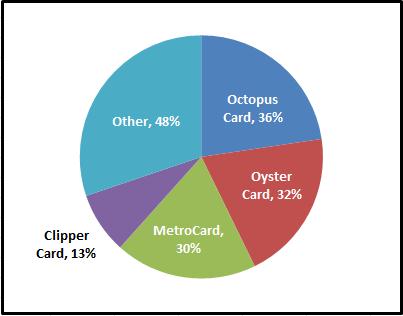Fun Poll Results: Many of you have tried different smart-card systems!
Fun Poll Results: Many of you have tried different smart-card systems!
Two weeks ago, we asked you what kind of electronic fare-systems you have tried around the world.
This week, we get to take a look at the results!
Out of the total 164 votes, 36% of voters have tried the Octopus Card. Hong Kong had introduced the system in 1997, which now boasts over 23 million cards in circulation.
The Oyster card was launched in 2003 and was designed, developed and installed by Cubic Transportation Systems – the company behind TransLink’s Compass Card.
New York City introduced the MetroCard with the magnetic strip in 1993, and adopted the new contact-less smart card system in 2007, also manufactured by Cubic Transportation Systems, Inc.
Votes for the Oyster Card and MetroCard are super close – 32% of Buzzer voters have used the Oyster Card, and 30% have tried the MetroCard.
The Clipper Card for the San Francisco Bay Area, trails behind at 13% of voters indicating they’ve tried the card.
Fun fact: the Clipper card was initially introduced as “TransLink” by the Metropolitan Transpotation Commission as a pilot program! It was later rebranded in 2010 as the Clipper Card.
A whopping 48% of our voters have tried a smart-card that’s not listed here.
Wanna know more about Compass Card? Check out all the Buzzer posts here.
Author: Angela Chang







Not to be too nit-picky, but the percentages in your pie chart add up to more than 100%. I recall that the poll allowed multiple selections, so that’s probably why.
(For the record, I selected the NYC MTA Metrocard.)
Ya, adding up to more than 100 percent is just par for the course for Translink that never can be responsible with other peoples’ money.
To Eric B and eee: It just means more pie to share with everyone! But yes, Eric, you are absolutely correct. The percentages add up to more than 100% because we allowed voters to choose more than one option. Thank you for participating!
Pie charts work best with amounts that add up to 100. Any deviation and you lose the insight you’re trying to convey with a graphic. In this case, 48% of people who took the poll checked “other” but it takes up a much smaller space on the pie than one might expect.
In the future, a bar graph would be much more appropriate given the multiple data points. You could even colour code the individual bars to show smart card systems made by a particular manufacturer or in specific countries!
If you’re particularly creative, I’ve seen some interesting data comparisons using Venn Diagrams with different sized shapes and the overlap to show which groups of people selected different groups of options. Mind you, this can get complicated after about 4 or different 5 data inputs, but it might be fun to try if you put out a poll with 3 options or so.
@ eee
Isn’t “never” a bit of an exaggeration? How would you know? Have you monitored every bit of their income/revenue/funding?
Wow It’s really nice information
kgf chapter 2
smart card systems are great for any poll
ibomma app
India post recruitment 2022
Alipurduar Recruitment 2022
karmai dharma scheme
I find your thoughts on this article are awesome. Thanks for sharing this with us.
Amazon ERC Number
lower division clark recruitment 2022
for latest job updates please visit our website:
ctet 2022
সিটেট ২০২২
Please visit our website for latest job updates-
west bengal govt jobs
govt of west bengal jobs
please our website for latest job update-
hdfc scholarship 2022
west bengal teacher recruitment 2022
ibps recruitment 2022
for latest job updates please visit our website-
Kolkata Metro Recruitment 2022
i am very glad to read this article it was very deep and informational article
Download WB Primary TET Admit Card 2022-
wb primary tet admit card 2022
wb tet admit card 2022
The full form of klpd is “Khade Lund Pe Dhoka“. KLPD is a slang term used in some parts of India, particularly in the Hindi-speaking regions.